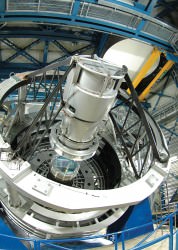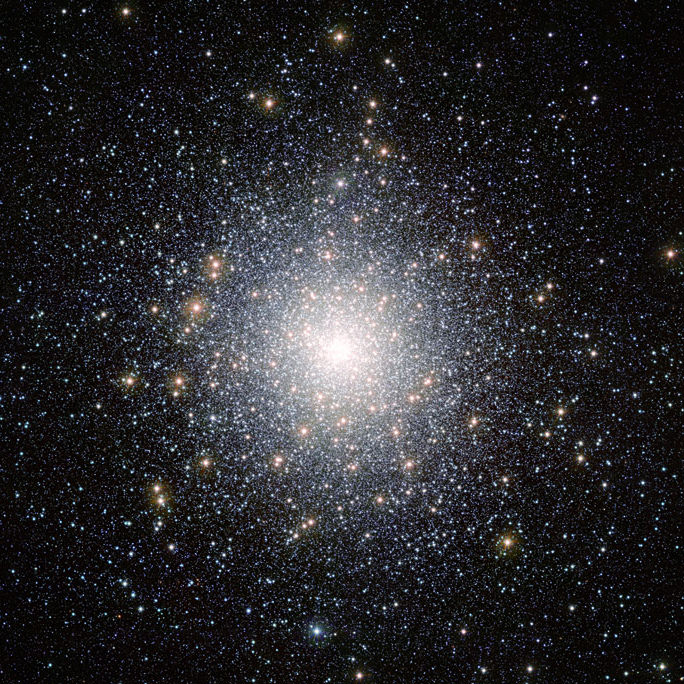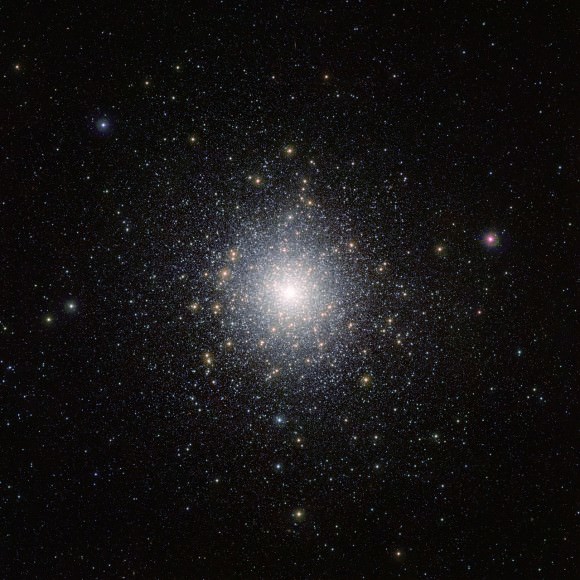Infrared image of globular cluster 47 Tucanae (NGC 104) captured by ESO’s VISTA telescope.
“My god, it’s full of stars!” said Dave Bowman in the movie 2010 as he entered the monolith, and one could imagine that the breathtaking view before him looked something like this.
Except this isn’t science fiction, it’s reality — this is an image of globular cluster 47 Tucanae taken by the European Southern Observatory’s VISTA telescope at the Paranal Observatory in Chile. It reveals in stunning detail a brilliant collection of literally millions of stars, orbiting our Milky Way galaxy at a distance of 15,000 light-years.
The full image can be seen below.
47 Tucanae (also known as NGC 104) is located in the southern constellation Tucana. It’s bright enough to be seen without a telescope and, even though it’s very far away for a naked-eye object, covers an area about the size of the full Moon.
In reality the cluster is 124 light-years across.
Although globular clusters like 47 Tucanae are chock-full of stars — many of them very old, even as stars go — they are noticeably lacking in clouds of gas and dust. It’s thought that all the gaseous material has long since condensed to form stars, or else has been blown away by radiation and outbursts from the cluster’s exotic inhabitants.
At the heart of 47 Tucanae lie many curious objects like powerful x-ray sources, rapidly-spinning pulsars, “vampire” stars that feed on their neighbors, and strange blue stragglers — old stars that somehow manage to stay looking young. (You could say that a globular cluster is the cosmic version of a trashy reality show set in Beverly Hills.)
Red giants can be seen surrounding the central part of the cluster, old bloated stars that are running out of fuel, their outer layers expanding.
 The background stars in the image are part of the Small Magellanic Cloud, which was in the distance behind 47 Tucanae when this image was taken.
The background stars in the image are part of the Small Magellanic Cloud, which was in the distance behind 47 Tucanae when this image was taken.
VISTA is the world’s largest telescope dedicated to mapping the sky in near-infrared wavelengths. Located at ESO’s Paranal Observatory in Chile, VISTA is revealing new views of the southern sky. Read more about the VISTA survey here.
Image credit: ESO/M.-R. Cioni/VISTA Magellanic Cloud survey. Acknowledgment: Cambridge Astronomical Survey Unit



Actually it was “My God, it’s full of stars!” http://youtu.be/oALxLNOhI6I
And it was Space Odyssey 2001, not 2010.
It was in the 2001 book but not the film; it was put into the beginning of the 2010 film.
You’re right, I got the two mixed up.
Great picture BTW.
You’re right… the novel had the “Oh” but the film didn’t. (And that’s just the beginning of where the two diverge.)
It was in the movie 2001, a space oddesey.
Oh to see the sky from a planet inside that cluster!
Yes! I was wondering that! Would it be different actually from how we see it? Is our sun in a kind of cluster as well?? Perhaps all seems close and luminous but it is an image effect. Apparently our sky is also full of stars but most of them are not bright enough for us to see them at naked eye.
http://www.iac.es/gabinete/iacnoticias/winter98/xplaneta.htm
“Densities in the
cores of globular clusters range from 103-104 solar masses per pc3. Thus, while we have a
few stars within 1 pc of the Sun, in the centre of a globular cluster, there would be
thousands. The sky would be spectacular indeed, but there would be a high price to pay.
Sigurdsson (1992, ApJL 399, L95) discusses ways of forming planetary systems in globular
clusters, as well as the prospects for them surviving disruption by close encounters with
other stars. He concludes that in the core of an average cluster like 47 Tuc, a planet at
1 AU would survive for only a few hundred million years – an order of magnitude less
than the time it took us to involve.”
That doesn’t surprise me, most planets would probably end up like pinballs or any protoplanetary disks would just end up smeared thinly around the cluster leaving a load of wandering dwarf planets but then I wasn’t thinking of living there, just visiting one.
Do we have an idea of the stellar density in the centre of clusters like this?
Looks like a ‘micro’ singularity exploded? Got sparks?
Nice scope!
Globular clusters? Vampire stars? Brings to mind the delectable Mathilda May in “Lifeforce” where vampires from a globular cluster…
See: http://www.imdb.com/title/tt0086837/trivia?tab=tr&item=tr0748225
“(…) the sky of a planet located inside a globular cluster would be filled with so many brilliant stars that there would be no true night and perhaps nothing known of the universe beyond the cluster itself.” (“Sky & Telescope”, 7/99, p. 120)
“(…) Sir Arthur Eddington (…) imagined the inhabitants of a cloud-bound planet where perennial dense clouds had prevented scientists from ever knowing that there were stars. On the basis of the laws of physics, they could nonetheless deduce that balls of gas with masses in a certain range would be shaped by gravity and caused to contract until they began to shine. Imagine their pleasure, [he] wrote, if one day their clouds could be rolled back and these theoreticians could see the beautiful stars that they had predicted. (…) this story requires that the laws of physics be known to the scientists of this cloud-bound planet. On our own planet, the study of the stars has been a tremendous aid to the development of these physical laws (…).” (University Astronomy, Pasachoff, 1978, p. 16)